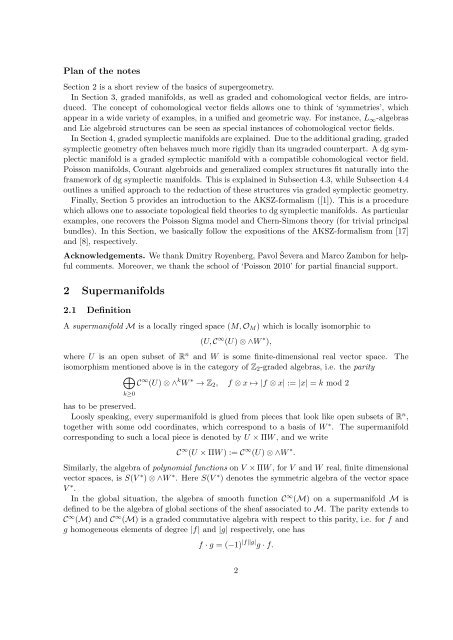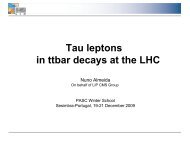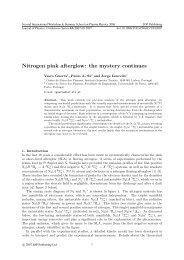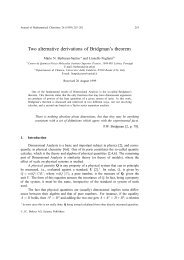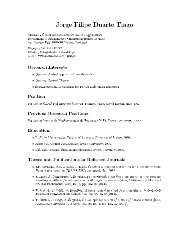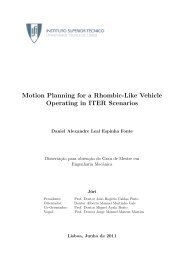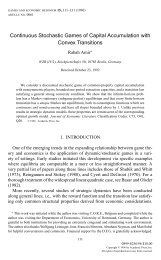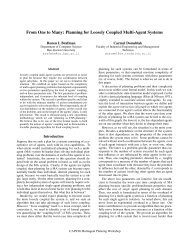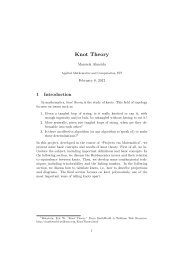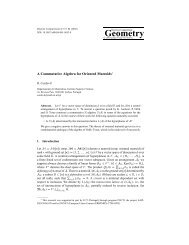Introduction to supergeometry
Introduction to supergeometry
Introduction to supergeometry
You also want an ePaper? Increase the reach of your titles
YUMPU automatically turns print PDFs into web optimized ePapers that Google loves.
Plan of the notes<br />
Section 2 is a short review of the basics of <strong>supergeometry</strong>.<br />
In Section 3, graded manifolds, as well as graded and cohomological vec<strong>to</strong>r fields, are introduced.<br />
The concept of cohomological vec<strong>to</strong>r fields allows one <strong>to</strong> think of ‘symmetries’, which<br />
appear in a wide variety of examples, in a unified and geometric way. For instance, L ∞ -algebras<br />
and Lie algebroid structures can be seen as special instances of cohomological vec<strong>to</strong>r fields.<br />
In Section 4, graded symplectic manifolds are explained. Due <strong>to</strong> the additional grading, graded<br />
symplectic geometry often behaves much more rigidly than its ungraded counterpart. A dg symplectic<br />
manifold is a graded symplectic manifold with a compatible cohomological vec<strong>to</strong>r field.<br />
Poisson manifolds, Courant algebroids and generalized complex structures fit naturally in<strong>to</strong> the<br />
framework of dg symplectic manifolds. This is explained in Subsection 4.3, while Subsection 4.4<br />
outlines a unified approach <strong>to</strong> the reduction of these structures via graded symplectic geometry.<br />
Finally, Section 5 provides an introduction <strong>to</strong> the AKSZ-formalism ([1]). This is a procedure<br />
which allows one <strong>to</strong> associate <strong>to</strong>pological field theories <strong>to</strong> dg symplectic manifolds. As particular<br />
examples, one recovers the Poisson Sigma model and Chern-Simons theory (for trivial principal<br />
bundles). In this Section, we basically follow the expositions of the AKSZ-formalism from [17]<br />
and [8], respectively.<br />
Acknowledgements. We thank Dmitry Royenberg, Pavol Ševera and Marco Zambon for helpful<br />
comments. Moreover, we thank the school of ‘Poisson 2010’ for partial financial support.<br />
2 Supermanifolds<br />
2.1 Definition<br />
A supermanifold M is a locally ringed space (M, O M ) which is locally isomorphic <strong>to</strong><br />
(U, C ∞ (U) ⊗ ∧W ∗ ),<br />
where U is an open subset of R n and W is some finite-dimensional real vec<strong>to</strong>r space.<br />
isomorphism mentioned above is in the category of Z 2 -graded algebras, i.e. the parity<br />
⊕<br />
C ∞ (U) ⊗ ∧ k W ∗ → Z 2 , f ⊗ x ↦→ |f ⊗ x| := |x| = k mod 2<br />
k≥0<br />
has <strong>to</strong> be preserved.<br />
Loosly speaking, every supermanifold is glued from pieces that look like open subsets of R n ,<br />
<strong>to</strong>gether with some odd coordinates, which correspond <strong>to</strong> a basis of W ∗ . The supermanifold<br />
corresponding <strong>to</strong> such a local piece is denoted by U × ΠW , and we write<br />
C ∞ (U × ΠW ) := C ∞ (U) ⊗ ∧W ∗ .<br />
Similarly, the algebra of polynomial functions on V × ΠW , for V and W real, finite dimensional<br />
vec<strong>to</strong>r spaces, is S(V ∗ ) ⊗ ∧W ∗ . Here S(V ∗ ) denotes the symmetric algebra of the vec<strong>to</strong>r space<br />
V ∗ .<br />
In the global situation, the algebra of smooth function C ∞ (M) on a supermanifold M is<br />
defined <strong>to</strong> be the algebra of global sections of the sheaf associated <strong>to</strong> M. The parity extends <strong>to</strong><br />
C ∞ (M) and C ∞ (M) is a graded commutative algebra with respect <strong>to</strong> this parity, i.e. for f and<br />
g homogeneous elements of degree |f| and |g| respectively, one has<br />
f · g = (−1) |f||g| g · f.<br />
The<br />
2


